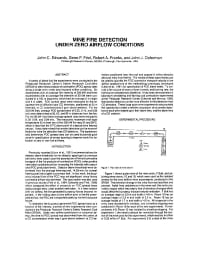Mining Publication: Mine Fire Detection Under Zero Airflow Conditions
Original creation date: February 1997
Authors: JC Edwards, GF Friel, RA Franks, JJ Opferman
NIOSHTIC2 Number: 20024592
Proceedings of the 6th International Mine Ventilation Congress, Chapter 52, Ramani RV, ed., Littleton, CO: Society for Mining, Metallurgy, and Exploration, Inc., 1997 Feb; :331-336
A series of diesel fuel fire experiments were conducted in the Pittsburgh Research Center's Safety Research Coal mine (SRCM) to determine products-of-combustion (POC) spread rates along a single entry under zero imposed airflow conditions. Six experiments with an average fire intensity of 330 kW and three experiments with an average fire intensity of 30 kW were conducted in a 180 m long entry which had an average 2 m heights and 4 m width. POC spread rates were measured by the response time of diffusion type CO detectors, positioned at 30 m intervals, to CO concentrations 5 ppm above ambient. For the 330 kW fires, average POC spread rates of 0.22, 0.13, and 0.06 m/s were determined at 30, 60, and 90 m distances from the fire. For the 30 kW fires these average spread rates were reduced to 0.08, 0.04, and 0.04 m/s. The measured maximum roof layer temperature 30 m from two of the 330 kW fire was 30 and 36 degrees C, which is less than the 57 degrees C alarm point of a typical mine thermal sensor. It was determined that smoke detectors can be more effective for mine fire detection than CO detectors. The experimentally determined POC spread rates can be used to provide guidance for specification of sensor spacing to improve early fire detection at zero or very low air flows.

NIOSHTIC2 Number: 20024592
Proceedings of the 6th International Mine Ventilation Congress, Chapter 52, Ramani RV, ed., Littleton, CO: Society for Mining, Metallurgy, and Exploration, Inc., 1997 Feb; :331-336
- Behavioral and Organizational Dimensions of Underground Mine Fires
- Impact of Air Velocity on the Detection of Fires in Conveyor Belt Haulageways
- In-Mine Evaluation of Smoke Detectors
- Mine Fire Source Discrimination Using Fire Sensors and Neural Network Analysis
- Multiple Type Discriminating Mine Fire Sensors
- Neural Network Application to Mine-Fire Diesel-Exhaust Discrimination
- Smoke, Carbon Monoxide, and Hydrogen Chloride Production from the Pyrolysis of Conveyor Belting and Brattice Cloth
- Technology News 497 - "You Are My Sunshine": A New Video Release From NIOSH on the Sunshine Mine Fire
- Technology News 498 - Multiple Fire Sensors for Mine Fire Detection and Nuisance Discrimination
- Technology News 549 - MFIRE 3.0 - NIOSH Brings MFIRE into 21st Century